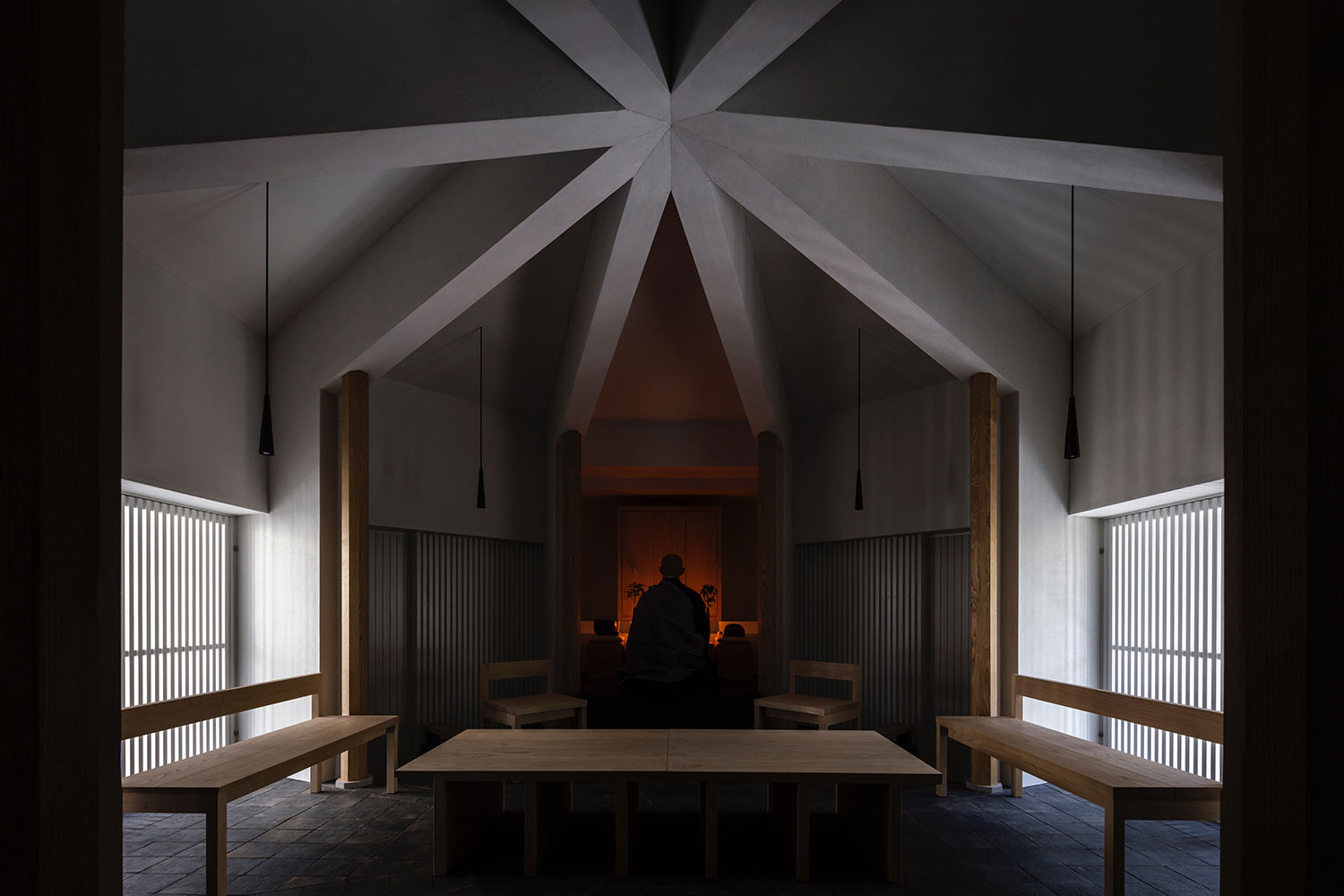Japan-based writer and traveller, specialising in design, lifestyle and travel journalism. Ron previously served as an editor of MING Magazine, ELLE Decoration and CREAM.
A construction project that my husband was involved in won an award. We were excited and dressed up to the award ceremony.
The architects, participants, and the clients of the winning projects all needed to go on stage for the award presentation. Everyone was dressed up formally. Our group stood out in the crowd because our client was wearing a cassock. The project that won us the award is the Jissou-ji Temple and the client is the temple’s abbot.

It is quite rare for temples to win modern architectural competitions. Many architecture lovers and students of the field actually visited the temple out of the reputation. I was amazed by the Jissou-ji Temple when I first saw it. An old pine tree that has been around for centuries is planted in the front yard. Behind the old pine tree, there is an octagonal funeral hall. According to architect Yamada Seiichi, octagonal symbolises the universe and the centre of the world in Buddhism. I have little knowledge of Buddhism. But when I walked into the funeral hall, I felt an immediate peace. Even though there was nobody in the hall at that moment, I could imagine that Yamada Seiichi and the abbot would wish the alive and the death could face the ultimate end peacefully, allowing people that are alive to feel relatable to death and nature.
The abbot has another vision for the Jissou-ji Temple, which directly addresses a challenge that most temples face in Japan currently. Temples used to be the centre of Japanese communities. It is the place where people pray and attend funerals. Residents and children from the neighbourhoods would also go to the temple to relax. However, as more old now live alone and nuclear family becomes the mainstream norm in Japan, temples are drifting away from the residents. This is especially true for the young generation. Except for tourists temples like Kiyomizu-dera Temple, young people barely set foot in traditional temples.
There are three operation models among Japanese temples. First, we have danka temples. Danka refers to the families of the temples’ followers. Danka temples generally provide their followers with funeral services, most of which have their own cemetery. Danka temples’ main source of income relies on the donation from the dankas and the management fee of the cemetery. Secondly, there are temples for followers. This type of temples offers followers a place to pray and rely on donation and selling amulets and souvenirs to operate. Lastly, we also have temples for tourism. For instance, temples like Kiyomizu-dera and Jisho-Ji charge visitors for entering the temples. The first two types of temples which rely on donation coming from the followers have been experiencing financial challenge as temples are becoming less important in people’s life. Scholar Hidenori Ukai has explored this problem and came up with the book The Annihilation of Temples: the Disappearing Local and Religion (Japanese title: 寺院消滅—失われる「地方」と「宗教」). The book discusses how the decrease of the Japanese population, decline of villages and the simplification of funeral bring operation crisis to Japanese temples. In Japan, there are around 77,000 temples across the country. Approximately 20,000 temples have been abandoned due to operation failure. According to Hidenori Ukai’s estimate, another 10,000 temples will be abandoned in the coming 15 years. Temple owners will have to invest more efforts in solving problems like attracting donation, increasing income, etc.
In 2008, Hideki Hashimoto took over the Kensyou-in temple, which is located in Kumagaya City in Saitama Prefecture, from his father as an abbot. He then attracted immense attention nationally as he decided to abandon the danka system. Believers will need to pay JPY30,000 to put the cremains of their families in the temple. The temple also provides different kinds of funeral services. Kensyou-in Temple also allows its clients to ship the cremains to the temple. Other services including funeral arrangement and cremains management are clearly priced on its official website. This move has helped Kensyou-in Temple improve its financial situation, earning three times more than the past. However, the temple has also been under criticism since Hideki Hashimoto is seemingly commercialising religion. “My father was an abbot. I am also married. I can’t really say I am not bothered by mundane matters like an ascetic,” Hideki Hashimoto commented on the criticism. “I am merely providing funeral services for people who need them.” It makes sense. When you are enjoying a service, you need to pay. In fact, traditional temples also charge people for performing traditional rituals and funerals. The difference here is that traditional temples keep the prices as a secret. Hideki Hashimoto revealed that in the past he received JPY800,000 for performing funeral services. He then needed to pay JYP550,000 to the temple that acted as an agency. From his perspective, it is the ambiguous and expensive pricing that is pushing the young generation away from traditional Buddhist funeral rituals and contributing greatly to the decline of Japanese temples.
There are a number of shrines in Kyoto that invest efforts in the promotion campaign. For example, we have the Kawai Shrine near Shimogamo Shrine. The Kawai Shrine’s pronunciation is very close to Kawaii, which means cute in Japanese. The temple then appeals to female tourists by promoting the God of cuteness. Kifune-jinja Shrine, on the other hand, appeals to the public with its special fortune-telling poems that will only reveal when soaked in water. Traditional Buddhist temples might be held back by the baggage of abstinence tradition when they face the dilemma of trying to survive. But I believe the most important is that the nature of religion does not change no matter the temple is modernised or temples change their way to charge people.